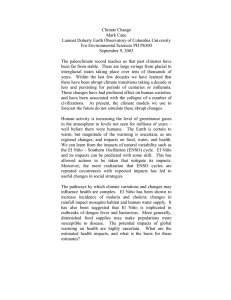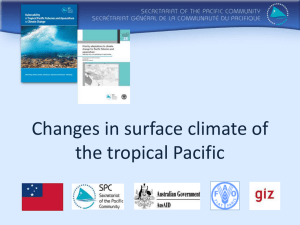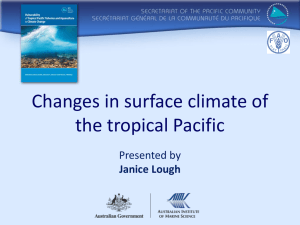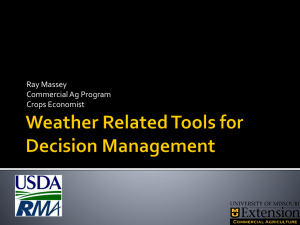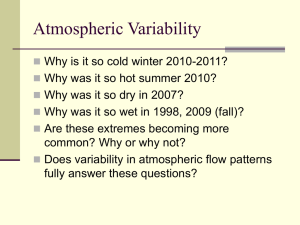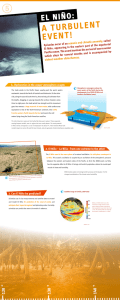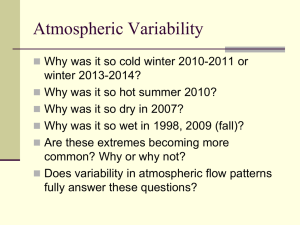Large-scale climate oscillations influencing Canada
advertisement
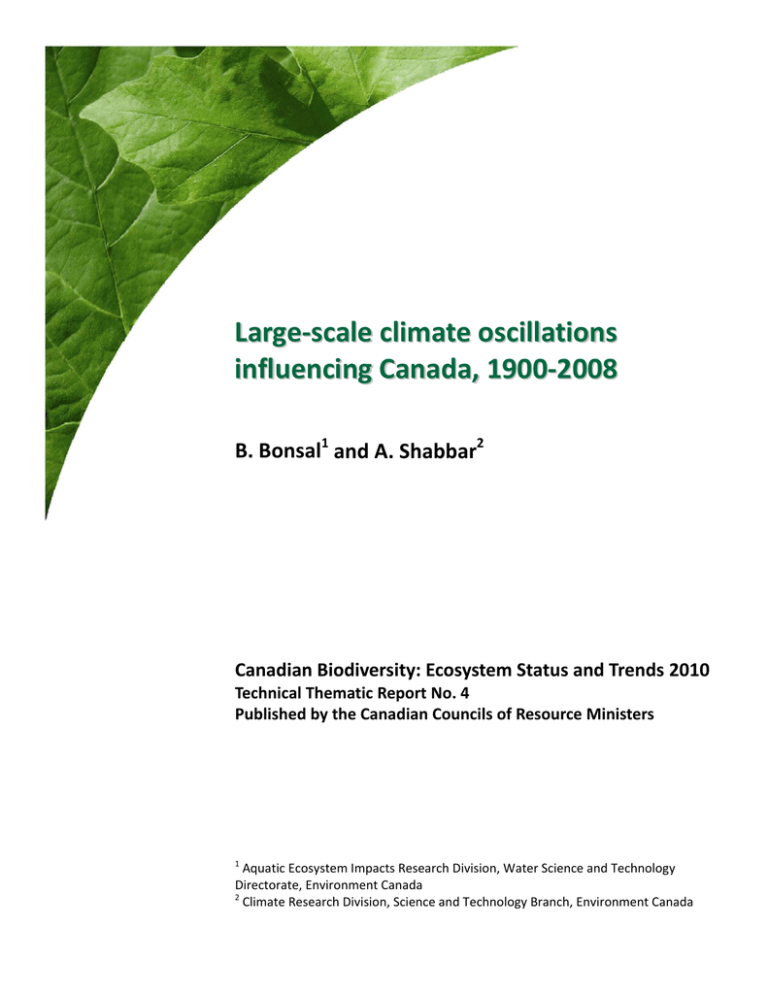
Large‐scale climate oscillations influencing Canada, 1900‐2008 B. Bonsal1 and A. Shabbar2 Canadian Biodiversity: Ecosystem Status and Trends 2010 Technical Thematic Report No. 4 Published by the Canadian Councils of Resource Ministers 1 Aquatic Ecosystem Impacts Research Division, Water Science and Technology Directorate, Environment Canada 2 Climate Research Division, Science and Technology Branch, Environment Canada Library and Archives Canada Cataloguing in Publication Large-scale climate oscillations influencing Canada, 1900-2008. Issued also in French under title: Oscillations climatiques à grande échelle ayant une incidence sur le Canada, de 1900 à 2008. Electronic monograph in PDF format. ISBN 978-1-100-18483-8 Cat. no.: En14-43/4-2011E-PDF Information contained in this publication or product may be reproduced, in part or in whole, and by any means, for personal or public non-commercial purposes, without charge or further permission, unless otherwise specified. You are asked to: • Exercise due diligence in ensuring the accuracy of the materials reproduced; • Indicate both the complete title of the materials reproduced, as well as the author organization; and • Indicate that the reproduction is a copy of an official work that is published by the Government of Canada and that the reproduction has not been produced in affiliation with or with the endorsement of the Government of Canada. Commercial reproduction and distribution is prohibited except with written permission from the Government of Canada’s copyright administrator, Public Works and Government Services of Canada (PWGSC). For more information, please contact PWGSC at 613-996-6886 or at droitdauteur.copyright@tpsgc-pwgsc.gc.ca. This report should be cited as: Bonsal, B. and Shabbar, A. 2011. Large-scale climate oscillations influencing Canada, 1900-2008. Canadian Biodiversity: Ecosystem Status and Trends 2010, Technical Thematic Report No. 4. Canadian Councils of Resource Ministers. Ottawa, ON. iii + 15 p. http://www.biodivcanada.ca/default.asp?lang=En&n=137E1147-0 © Her Majesty the Queen in Right of Canada, 2011 Aussi disponible en français PREFACE The Canadian Councils of Resource Ministers developed a Biodiversity Outcomes Framework 1 in 2006 to focus conservation and restoration actions under the Canadian Biodiversity Strategy. 2 Canadian Biodiversity: Ecosystem Status and Trends 2010 3 was a first report under this framework. It assesses progress towards the framework’s goal of “Healthy and Diverse Ecosystems” and the two desired conservation outcomes: i) productive, resilient, diverse ecosystems with the capacity to recover and adapt; and ii) damaged ecosystems restored. The 22 recurring key findings that are presented in Canadian Biodiversity: Ecosystem Status and Trends 2010 emerged from synthesis and analysis of technical reports prepared as part of this project. Over 500 experts participated in the writing and review of these foundation documents. This report, Large-scale climate oscillations influencing Canada, 1900-2008, is one of several reports prepared on the status and trends of national cross-cutting themes. It has been prepared and reviewed by experts in the field of study and reflects the views of its authors. Acknowledgements The authors are grateful to Heather Haywood and Ross Mackay of Environment Canada for assistance with the figures. We would also like to thank the two reviewers for their helpful comments and suggestions toward an improved version of the report. 1 Environment Canada. 2006. Biodiversity outcomes framework for Canada. Canadian Councils of Resource Ministers. Ottawa, ON. 8 p. http://www.biodivcanada.ca/default.asp?lang=En&n=F14D37B9-1 2 Federal-Provincial-Territorial Biodiversity Working Group. 1995. Canadian biodiversity strategy: Canada's response to the Convention on Biological Diversity. Environment Canada, Biodiversity Convention Office. Ottawa, ON. 86 p. http://www.biodivcanada.ca/default.asp?lang=En&n=560ED58E-1 3 Federal, Provincial and Territorial Governments of Canada. 2010. Canadian biodiversity: ecosystem status and trends 2010. Canadian Councils of Resource Ministers. Ottawa, ON. vi + 142 p. http://www.biodivcanada.ca/default.asp?lang=En&n=83A35E06-1 i Ecological Classification System – Ecozones+ A slightly modified version of the Terrestrial Ecozones of Canada, described in the National Ecological Framework for Canada, 4 provided the ecosystem-based units for all reports related to this project. Modifications from the original framework include: adjustments to terrestrial boundaries to reflect improvements from ground-truthing exercises; the combination of three Arctic ecozones into one; the use of two ecoprovinces – Western Interior Basin and Newfoundland Boreal; the addition of nine marine ecosystem-based units; and, the addition of the Great Lakes as a unit. This modified classification system is referred to as “ecozones+” throughout these reports to avoid confusion with the more familiar “ecozones” of the original framework. 5 4 Ecological Stratification Working Group. 1995. A national ecological framework for Canada. Agriculture and AgriFood Canada, Research Branch, Centre for Land and Biological Resources Research and Environment Canada, State of the Environment Directorate, Ecozone Analysis Branch. Ottawa/Hull, ON. 125 p. Report and national map at 1:7 500 000 scale. 5 Rankin, R., Austin, M. and Rice, J. 2011. Ecological classification system for the ecosystem status and trends report. Canadian Biodiversity: Ecosystem Status and Trends 2010, Technical Thematic Report No. 1. Canadian Councils of Resource Ministers. Ottawa, ON. http://www.biodivcanada.ca/default.asp?lang=En&n=137E1147-0 ii Table of Contents PREFACE ......................................................................................................................................................... I Acknowledgements ................................................................................................................................ i Ecological Classification System – Ecozones+ ........................................................................................ ii LIST OF FIGURES ........................................................................................................................................... III INTRODUCTION ............................................................................................................................................. 1 MAIN OSCILLATIONS INFLUENCING CANADA ............................................................................................... 2 El Niño/Southern Oscillation ................................................................................................................. 2 Pacific Decadal Oscillation .................................................................................................................... 3 Pacific North American Pattern ............................................................................................................ 4 North Atlantic Oscillation/Arctic Oscillation ......................................................................................... 5 Atlantic Multi-Decadal Oscillation......................................................................................................... 6 IMPACTS ON CANADIAN CLIMATE ................................................................................................................ 7 Cold season temperature ...................................................................................................................... 7 Cold season precipitation...................................................................................................................... 9 Summer climate .................................................................................................................................. 10 TRENDS IN LARGE-SCALE OSCILLATIONS AND CANADIAN CLIMATE .......................................................... 11 REFERENCES ................................................................................................................................................ 13 List of Figures Figure 1. Southern Oscillation Index for the period 1900 to 2008. .................................................... 2 Figure 2. Pacific Decadal Oscillation Index for the period 1900 to 2008............................................ 3 Figure 3. Pacific North American Pattern Index for the period 1950 to 2008.................................... 4 Figure 4. North Atlantic Oscillation Index for the period 1900 to 2008. ............................................ 5 Figure 5. Atlantic Multi-Decadal Oscillation Index for the period 1900 to 2008................................ 6 Figure 6. Typical regions of Canada impacted by the different phases of ENSO, the PDO, the PNA pattern, and the NAO during the cold season: temperature. ..................................... 8 Figure 7. Typical regions of Canada impacted by the different phases of ENSO, the PDO, the PNA pattern, and the NAO during the cold season: precipitation...................................... 9 Figure 8. Typical regions of Canada impacted by ENSO and the AMO during the summer season. .............................................................................................................................. 11 iii INTRODUCTION Observed trends and variability in Canadian climate are influenced by large-scale atmospheric and oceanic oscillations known as teleconnections. Although there are several identified teleconnection patterns used to describe various circulation features across the globe, the main oscillations impacting Canada include El Niño/Southern Oscillation (Rasmusson and Carpenter, 1982), the Pacific Decadal Oscillation (Mantua et al., 1997), the Pacific North American pattern (Wallace and Gutzler, 1981), the North Atlantic Oscillation (e.g. Hurrell and VanLoon, 1997; Hurrell et al., 2003) -- which is closely related to the Arctic Oscillation (Thompson and Wallace, 1998), and the Atlantic Multi-Decadal Oscillation (Mestas-Nuñez and Enfield, 1999). Relationships between these teleconnections and Canadian climate are strongest during the cold season (late autumn through spring) although some connections with summer conditions have been identified. In addition, they have strongest and more consistent impacts on temperature variables and to a lesser extent, on precipitation related factors. 1 MAIN OSCILLATIONS INFLUENCING CANADA El Niño/Southern Oscillation The El Niño/Southern Oscillation (ENSO) represents large-scale ocean-atmosphere oscillations in the tropical Pacific that influence climatic conditions around the globe including Canada. It consists of two phases, namely warm El Niño events and cool La Niña events which tend to occur on average, every two to seven years. ENSO variability is often measured by the difference in surface pressure anomalies between Tahiti and Darwin (known as the Southern Oscillation Index or SOI) and sea-surface temperatures (SSTs) in the equatorial Pacific. Figure 1 shows time series of seasonal SOI values from 1900 to 2008 with negative (positive) values representative of El Niño (La Niña) conditions. The graph reveals considerable variability over time. Strong events occurred through the first 25 years of the 20th century with few events of note through the middle portion of the 1900s. There is, however, a discernible shift in the mid 1970s toward more prolonged and intense El Niño episodes (that is, negative SOI values). This shift was influenced by a decadal-scale change in atmosphere-ocean conditions over the Pacific and western North America around 1976 (e.g. Trenberth and Hurrell, 1994) that is also evident in the Pacific Decadal Oscillation (see page 3). The most notable El Niño events in recent times occurred during the winters of 1982-1983 and 1997-1998. 3 Standardized anomaly 2 1 0 -1 -2 -3 -4 1900 1910 1920 1930 1940 1950 1960 1970 1980 1990 2000 Figure 1. Southern Oscillation Index for the period 1900 to 2008. Values are presented as standardized anomalies that are calculated by dividing each anomaly (i.e. difference from the long-term mean) by the long-term standard deviation. Five-year running means for each series are also provided (purple line). Source: data for 1901 to 1950 are from ftp://ftp.cpc.ncep.noaa.gov/wd52dg/data/indices/soi.his and data for 1951 to 2008 are from http://www.cpc.ncep.noaa.gov/data/indices/soi Accessed 09/11/09 2 Pacific Decadal Oscillation The Pacific Decadal Oscillation (PDO) is a measure of SSTs in the North Pacific that has a very strong correlation with the intensity of the Aleutian Low (Mantua et al., 1997). Positive PDO are characterized by colder than normal (i.e., long-term average) SSTs in the east-central North Pacific and warmer SSTs along the west coast of North America and vice versa. Although Pacific SSTs associated with the PDO and ENSO are somewhat spatially similar (with extratropical anomalies being emphasized in the PDO relative to ENSO), they have very different behaviour in time with PDO cycles persisting for 20 to 30 years. This is clearly evident in Figure 2 which shows the decadal nature of the PDO with shifts occurring around 1925, 1947, and 1976. As noted previously, the change toward positive PDO in the late 1970s also coincides with a shift toward more frequent El Niño events (see Figure 1). 3 Standardized anomaly 2 1 0 -1 -2 -3 1900 1910 1920 1930 1940 1950 1960 1970 1980 1990 2000 Figure 2. Pacific Decadal Oscillation Index for the period 1900 to 2008. Values are presented as standardized anomalies that are calculated by dividing each anomaly (i.e., difference from the long-term mean) by the long-term standard deviation. Five-year running means for each series are also provided (purple line). Source: http://jisao.washington.edu/pdo/PDO.latest Accessed 09/11/09 3 Pacific North American Pattern The Pacific North American (PNA) pattern represents an upper-atmospheric wave structure featuring a sequence of high and low-pressure anomalies stretching from the sub-tropical west Pacific to the east coast of North America. The positive phase of the PNA features anomalous high pressure near Hawaii and over western Canada, and below average pressures in the central and eastern North Pacific (i.e., a deeper than normal Aleutian Low) and over the southeastern United States. Although the PNA is a natural internal mode of climate variability, it is also strongly influenced by ENSO with positive PNA tending to occur during winters associated with El Niño episodes, and negative values during La Niña events. Based on 1950 to 2008 data, approximately 51% of the PNA occurrences coincide with ENSO. Time series of seasonal PNA values from 1950 to 2008 (Figure 3) show considerable variability although, as with ENSO and PDO, there is a tendency for more positive PNA since the mid 1970s, particularly during winter. 2.0 Standardized anomaly 1.5 1.0 0.5 0.0 -0.5 -1.0 -1.5 -2.0 1900 1910 1920 1930 1940 1950 1960 1970 1980 1990 2000 Figure 3. Pacific North American Pattern Index for the period 1950 to 2008. Values are presented as standardized anomalies that are calculated by dividing each anomaly (i.e., difference from the long-term mean) by the long-term standard deviation. Five-year running means for each series are also provided (purple line). Source: http://www.cdc.noaa.gov/correlation/pna.data Accessed 09/11/09 4 North Atlantic Oscillation/Arctic Oscillation The North Atlantic Oscillation (NAO) represents the dominant mode of atmospheric variability over the North Atlantic and is most pronounced during the cold season. The NAO index (Figure 4) is a measure of the difference in the strength of the Icelandic Low and the Azores High and has been shown to affect climate over Europe and eastern Canada. Positive NAO are associated with a deeper than normal Icelandic Low and a stronger than normal Azores High, while negative values represent opposite conditions. During the last century, the NAO has demonstrated considerable inter-annual and inter-decadal variations with little evidence of a long-term trend. The Arctic Oscillation (AO) represents atmospheric circulation variability over the extra-tropical Northern Hemisphere where sea-level pressures over the polar regions varies in opposition with that over middle latitudes (about 45°N) (Thompson and Wallace, 1998). It has also been referred to as the Northern Hemisphere Annular Mode. Note that the NAO and the AO are shown to be highly correlated in time, suggesting the NAO is merely a regional manifestation of the hemispheric-scale (AO) (Thompson and Wallace, 1998). Furthermore, the effects of both oscillations on temperature and precipitation in Canada are nearly the same and as a result, only relationships with the NAO are presented in this review. 4 Standardized anomaly 3 2 1 0 -1 -2 -3 1900 1910 1920 1930 1940 1950 1960 1970 1980 1990 2000 Figure 4. North Atlantic Oscillation Index for the period 1900 to 2008. Values are presented as standardized anomalies that are calculated by dividing each anomaly (i.e. difference from the long-term mean) by the long-term standard deviation. Five-year running means for each series are also provided (purple line). Source: http://www.cru.uea.ac.uk/~timo/projpages/nao_update.htm Accessed 09/11/09 5 Atlantic Multi-Decadal Oscillation The Atlantic Multi-Decadal Oscillation (AMO) is a mode of natural variability representing multi-decadal changes in North Atlantic SSTs with cool and warm periods lasting for 20-40 years over an approximate range of +/- 0.4° C. It is defined as the first rotated empirical orthogonal function of global SSTs from which intra-seasonal ENSO and local trends have been removed (Mestas-Nuñez and Enfield, 1999). To the authors’ knowledge, no dynamical relationship has been established between the atmospheric NAO and the oceanic AMO. Whereas the AMO has a uniform polarity in SSTs across the entire North Atlantic and operates on a multi-decadal scale, the NAO represents atmospheric variability with a dipole pattern in the North Atlantic and varies mainly on a quasi-decadal temporal scale (Arguez et al., 2009). The AMO series displays cool phases during 1905 to 1925 and 1970 to 1990, and warm phases from 1930 to 1960 and beginning again in the mid-1990s through the present (Figure 5). 0.6 Standardized anomaly 0.4 0.2 0.0 -0.2 -0.4 -0.6 1900 1910 1920 1930 1940 1950 1960 1970 1980 1990 2000 Figure 5. Atlantic Multi-Decadal Oscillation Index for the period 1900 to 2008. Values are presented as standardized anomalies that are calculated by dividing each anomaly (i.e., difference from the long-term mean) by the long-term standard deviation. Five-year running means for each series are also provided. Source: http://www.esrl.noaa.gov/psd/data/correlation/amon.us.long.data Accessed 09/11/09 6 IMPACTS ON CANADIAN CLIMATE Cold season temperature The strongest links between large-scale teleconnections and Canadian climate occur with coldseason temperature. The greatest inter-annual variation in winter temperature is, to a large extent, controlled by ENSO. In particular, the anomalous heating in the eastern tropical Pacific associated with El Niño, triggers upper-atmospheric waves which give rise to a positive PNAlike pattern over North America (Wallace and Gutzler, 1981). The initiation of this pattern leads to warmer than normal temperatures that spread eastward from the west coast to central Canada during late autumn to early spring following the onset of El Niño episodes (Shabbar and Khandekar, 1996) (see Figure 6). In addition, the frequency and duration of winter warm spells are significantly enhanced and cold spells significantly decreased during El Niño winters (Shabbar and Bonsal, 2004). Temperature responses to La Niña events are for the most part, opposite with colder than normal winters (including a higher frequency of cold spells) over western and central Canada. However, La Niña effects are often more concentrated in the west relative to those associated with El Niño (Hoerling et al., 1997; Hsieh et al., 2009). It should also be noted that individual ENSO event temperature responses vary considerably, both temporally and spatially. As alluded to previously, the PNA also occurs in the absence of large-amplitude ENSO events. On average, the positive phase of the PNA pattern is associated with aboveaverage temperatures over western Canada in a region similar to that for El Niño, but extending further into northern Canada and confined to the westernmost four provinces (Figure 6). Negative PNA winters are associated with colder temperatures in this region (see Climate Prediction Center Internet Team, 2005b). On longer time scales, cold-season temperature variations over Canada have been associated with North Pacific atmosphere-ocean variability as measured by the PDO. Bonsal et al. (2001) determined that positive PDO periods were significantly related to warmer than normal winter temperatures over western and central regions of the country on both inter-decadal and interannual scales (and vice versa) (Figure 6). They also found that El Niño (La Niña) related temperature responses were stronger and more consistent during positive (negative) phases of the PDO (for more details see Figures 4 and 5 in Bonsal et al., 2001). 7 Figure 6. Typical regions of Canada impacted by the different phases of ENSO, the PDO, the PNA pattern, and the NAO during the cold season: temperature. Warmer (colder) than normal temperatures occur in the designated regions during El Niño (La Niña) events, positive (negative) PDO, positive (negative) PNA, and negative (positive) NAO. Teleconnection relationships over eastern Canada are generally not as strong when compared to the west. The main climatic driver in this region is the NAO which during the cold season, impacts temperatures over northeastern regions of the country (Figure 6). This includes colder than normal winters in association with positive NAO and vice versa (Bonsal et al., 2001). The colder temperatures are related to an intensified Icelandic Low that results in increased frequencies of northerly flow into northeastern Canada. Due to the strong association between the NAO and the AO, anomalously cold temperatures are also observed over in this region of Canada during positive phases of the AO. It should be noted that the aforementioned associations between these large-scale oscillations and cold-season temperatures over various regions of Canada have also resulted in significant relationships between these teleconnection patterns and several ecosystem-related variables over the country. These include for example, the duration of lake and river ice (Bonsal et al., 2006) the timing of snowmelt and spring peak streamflow (Stewart et al., 2005; Burn, 2008), the onset of spring (Bonsal and Prowse, 2003; Schwartz et al., 2006), and even the occurrence and mortality of the mountain pine beetle in western Canada (Stahl et al., 2006a). 8 Cold season precipitation Although not as strong as temperature, significant relationships between large-scale teleconnections and Canadian cold-season precipitation have also been identified (Figure 7). In particular, winters following the onset of El Niño are generally associated with a distinct pattern of below normal precipitation stretching from southern British Columbia, through the Prairies, and into the Great Lakes region. La Niña events lead to an opposite response (Shabbar et al., 1997). Links between the PDO and winter precipitation are also evident, but these effects are confined to western Canada (southern Yukon, British Columbia and Alberta, and southern Saskatchewan and Manitoba) where positive PDO are associated with below normal precipitation and vice versa (see Figure 7) (Bonsal et al., 2001). Figure 7. Typical regions of Canada impacted by the different phases of ENSO, the PDO, the PNA pattern, and the NAO during the cold season: precipitation. Below (above) average precipitation is associated with El Niño (La Niña) events, positive (negative) PDO, positive (negative) PNA, and positive (negative) NAO. As with temperature, El Niño (La Niña) precipitation responses in western Canada tend to be amplified during positive (negative) PDO phases (e.g. Kiffney et al., 2002; Stahl et al., 2006b). The PNA winter precipitation response tends to be confined to most of Alberta (Figure 7) (see 9 Climate Prediction Center Internet Team, 2005a) where positive PNA is associated with below average values and vice versa. Some investigations have also found that positive PNA periods were significantly correlated with reduced snow cover in western Canada during all seasons (Brown and Goodison, 1996). The effect of NAO on Canadian precipitation is modest and generally restricted to northeastern regions where positive values are associated with lower than normal winter precipitation (Figure 7). The positive NAO allows for more frequent outbreaks of cold, dry Arctic air thus resulting in less precipitable moisture. Note that these teleconnection – precipitation relationships have also been reflected in streamflow characteristics over various regions of the country. In particular, over western Canada, there is a higher frequency of low streamflow events in association with the drier conditions during El Niño events and positive phases of the PDO and the PNA pattern (and vice versa). In northeastern regions of the country, reduced stream flows occur during positive phases of NAO and the AO (see Bonsal and Shabbar, 2008 and references therein for a detailed summary of relationships between large-scale oscillations and stream flow in Canada). Summer climate Relationships between teleconnections and summer climate over Canada are not as strong and/or consistent as compared to the cold season. Nonetheless, there have been some studies that have identified various associations with drought-like conditions during the summer period. Bonsal and Lawford (1999) indicated that during the majority of El Niño events, persistence of a North Pacific SST pattern consisting of anomalously cold water in the eastcentral North Pacific and anomalously warm water along the west coast of North America led to extended summer dry spells on the Canadian Prairies. In addition, Shabbar and Skinner (2004) found that El Niño events led to a summer moisture deficit in western Canada, while La Niña events produced an abundance of moisture, mainly in extreme western Canada. They also determined that the positive phase of the winter AMO tends to be associated with summer dry conditions over the central and northern regions of the Canadian Prairies, the lower Great Lakes and St. Lawrence Valley, and portions of the west coast of Canada (see Figure 8). Other ecosystem-related studies have revealed that El Niño events and the positive phase of PDO lead to drier conditions and higher forest fire severity in western, northwestern, and parts of northeastern Canada. Conversely, La Niña events and negative PDO produce an excess in summer moisture and low fire severity over western regions of the country (Skinner et al., 2006). In addition, an analysis of tornado frequencies and ENSO suggest that the La Niña events tend to suppress tornadic activity in western Canada, while El Niño episodes tend to enhance it (Etkin et al., 2001). 10 Figure 8. Typical regions of Canada impacted by ENSO and the AMO during the summer season. Drier (wetter) than normal conditions occur in the designated regions during El Niño (La Niña) events and positive (negative) phases of the AMO. TRENDS IN LARGE-SCALE OSCILLATIONS AND CANADIAN CLIMATE It has been documented that the different phases in large-scale teleconnections have acted to amplify (or in some cases, dampen) observed climate trends over various regions of North America including Canada. As a result, a number of the observed 20th century climate changes can be attributed at least in part, to changes in these various teleconnection patterns (Solomon et al., 2007). Hurrell (1996), for example, found that the NAO, ENSO, and variations in North Pacific circulation collectively explained a significant portion of Northern Hemisphere winter temperature variability during the 20th century. Specifically for North America, the mid 1970s climate shift to positive PDO and more frequent El Niño events appear to have led to contrasting changes across the continent, as the west has warmed more than the east (Trenberth et al., 2007). This shift has therefore also been associated with the trend toward warmer winter and spring temperatures over western Canada. However, there is currently no consensus on 11 how increases in greenhouse gas concentrations have impacted the occurrence of these largescale climate oscillations. Furthermore, the effects of projected future climate change on the major teleconnection patterns affecting Canada remain uncertain since there is a lack of agreement among the various climate models concerning the future frequency and structure of large-scale atmospheric and oceanic modes. With respect to ENSO for example, the ability of current Global Climate Models (GCMs) to simulate observed El Niño and La Niña events differ considerably from one model to the next, however, these events are much better simulated using an ensemble of models. At present, the majority of GCMs do not indicate any discernible changes in the projected ENSO amplitude or frequency in the 21st century (Meehl et al., 2007). In summary, further advancements in GCMs are needed in order to detect future changes to largescale teleconnections and their resultant impacts on Canadian climate. 12 References Arguez, A., O'Brien, J.J. and Smith, S.R. 2009. Air temperature impacts over eastern North America and Europe associated with low-frequency North Atlantic SST variability. International Journal of Climatology 29:1-10. Bonsal, B.R. and Lawford, R.G. 1999. Teleconnections between El Niño and La Niña events and summer extended dry spells on the Canadian prairies. International Journal of Climatology 19:1445-1458. Bonsal, B.R. and Prowse, T.D. 2003. Trends and variability in spring and autumn 0 oC-isotherm dates over Canada. Climatic Change 57:341-358. Bonsal, B.R., Prowse, T.D., Duguay, C.R. and Lacroix, M.P. 2006. Impacts of large-scale teleconnections on freshwater-ice break/freeze-up dates over Canada. Journal of Hydrology 330:340-353. Bonsal, B.R. and Shabbar, A. 2008. Impacts of large-scale circulation variability on low streamflows over Canada: a review. Canadian Water Resources Journal 33:137-154. Bonsal, B.R., Shabbar, A. and Higuchi, K. 2001. Impacts of low frequency variability modes on Canadian winter temperature. International Journal of Climatology 21:95-108. Brown, R.D. and Goodison, B.E. 1996. Interannual variability in reconstructed Canadian snow cover, 1915-1992. Journal of Climate 9:1299-1318. Burn, D.H. 2008. Climatic influences on streamflow timing in the headwaters of the Mackenzie River Basin. Journal of Hydrology 352:225-238. Climate Prediction Center Internet Team. 2005a. Associated precipitation patterns Pacific/North American (PNA) [online]. NOAA/National Weather Service, National Centers for Environmental Prediction, Climate Prediction Center. http://www.cpc.noaa.gov/data/teledoc/pna_pmap.shtml (accessed 20 November, 2009). Climate Prediction Center Internet Team. 2005b. Associated temperature patterns Pacific/North American (PNA) [online]. NOAA/National Weather Service, National Centers for Environmental Prediction, Climate Prediction Center. http://www.cpc.noaa.gov/data/teledoc/pna_tmap.shtml (accessed 20 November, 2009). Etkin, D., Brun, S.E., Shabbar, A. and Joe, P. 2001. Tornado climatology of Canada revisited: tornado activity during different phases of ENSO. International Journal of Climatology 21:915-938. Hoerling, M.P., Kumar, A. and Zhang, M. 1997. El Niño, La Niña, and the nonlinearity of their teleconnections. Journal of Climate 10:1769-1786. Hsieh, W.W., Wu, A. and Shabbar, A. 2009. Non-linear atmospheric teleconnections. Geophysical Research Letters 33, L07714:4. doi:10.1029/2005GL025471. 13 Hurrell, J.W. 1996. Influence of variations in extratropical wintertime teleconnections on Northern Hemisphere temperature. Geophysical Research Letters 23:665-668. Hurrell, J.W., Kushnir, Y., Ottersen, G. and Visbek, M. 2003. The North Atlantic Oscillation: climatic significance and environmental impact. Geophysical Monograph Series No. 134. American Geophysical Union. Washington, DC. 279 p. Hurrell, J.W. and VanLoon, H. 1997. Decadal variations in climate associated with the North Atlantic Oscillation. Climatic Change 36:301-326. Kiffney, P.M., Bull, J.P. and Feller, M.C. 2002. Climatic and hydrologic variability in a coastal watershed of southwestern British Columbia. Journal of the American Water Resources Association 38:1437-1451. Mantua, N.J., Hare, S.R., Zhang, Y., Wallace, J.M. and Francis, R.C. 1997. A Pacific interdecadal climate oscillation with impacts on salmon production. Bulletin of the American Meteorological Society 78:1069-1079. Meehl, G.A., Stocker, T.F., Collins, W.D., Friedlingstein, P., Gaye, A.T., Gregory, J.M., Kitoh, A., Knutti, R., Murphy, J.M., Noda, A., Raper, S.C.B., Watterson, I.G., Weaver, A.J. and Zhao, Z.C. 2007. Global climate projections. In Climate change 2007: the physical science basis. Contribution of Working Group I to the Fourth Assessment Report of the Intergovernmental Panel on Climate Change. Edited by Solomon, S., Qin, D., Manning, M., Chen, Z., Marquis, M., Averyt, K.B., Tignor, M. and Miller, H.L. Cambridge University Press. Cambridge, UK and New York, NY. Chapter 10. Mestas-Nuñez, A.M. and Enfield, D.B. 1999. Rotated global modes of non-ENSO sea surface temperature variability. Journal of Climate 12:2734-2746. Rasmusson, E.M. and Carpenter, T.H. 1982. Variations in tropical sea-surface temperature and surface wind fields associated with the Southern Oscillation El-Niño. Monthly Weather Review 110:354-384. Schwartz, M.D., Ahas, R. and Aasa, A. 2006. Onset of spring starting earlier across the Northern Hemisphere. Global Change Biology 12:343-351. Shabbar, A. and Bonsal, B. 2004. Associations between low frequency variability modes and winter temperature extremes in Canada. Atmosphere-Ocean 42:127-140. Shabbar, A., Bonsal, B. and Khandekar, M. 1997. Canadian precipitation patterns associated with the Southern Oscillation. Journal of Climate 10:3016-3027. Shabbar, A. and Khandekar, M. 1996. The impact of El Niño-Southern Oscillation on the temperature field over Canada. Atmosphere-Ocean 34:401-416. Shabbar, A. and Skinner, W. 2004. Summer drought patterns in Canada and the relationship to global sea surface temperatures. Journal of Climate 17:2866-2880. 14 Skinner, W.R., Shabbar, A., Flannigan, M.D. and Logan, K. 2006. Large forest fires in Canada and the relationship to global sea surface temperatures. Journal of Geophysical ResearchAtmospheres 111. Solomon, S., Qin, D., Manning, M., Alley, R.B., Bernsten, T., Bindoff, N.L., Chen, Z., Chidthaisong, A., Gregory, J.M., Hergerl, G.C., Heimann, M., Hewitson, B., Hoskins, B.J., Joos, F., Jouzel, J., Kattsov, V., Lohmann, U., Matsuno, T., Molina, M., Nicholls, N., Overpeck, J., Raga, G., Ramaswamy, V., Ren, J., Rusticucci, M., Somervilles, R., Stocker, T.F., Whetton, P., Wood, R.A. and Wratt, D. 2007. Technical summary. In Climate change 2007: the physical science basis. Contribution of Working Group I to the Fourth Assessment Report of the Intergovernmental Panel on Climate Change. Edited by Solomon, S., Qin, D., Manning, M., Chen, Z., Marquis, M., Averyt, K.B., Tignor, M. and Miller, H.L. Cambridge University Press. Cambridge, UK and New York, NY. Stahl, K., Moore, R.D. and McKendry, I.G. 2006a. Climatology of winter cold spells in relation to mountain pine beetle mortality in British Columbia, Canada. Climate Research 32:13-23. Stahl, K., Moore, R.D. and McKendry, I.G. 2006b. The role of synoptic-scale circulation in the linkage between large-scale ocean-atmosphere indices and winter surface climate in British Columbia, Canada. International Journal of Climatology 26:541-560. Stewart, I.T., Cayan, D.R. and Dettinger, M.D. 2005. Changes toward earlier streamflow timing across western North America. Journal of Climate 18:1136-1155. Thompson, D.W.J. and Wallace, J.M. 1998. The Arctic Oscillation signature in the wintertime geopotential height and temperature fields. Geophysical Research Letters 25:1297-1300. Trenberth, K.E. and Hurrell, J.W. 1994. Decadal atmosphere-ocean variations in the Pacific. Climate Dynamics 9:303-319. Trenberth, K.E., Jones, P.D., Ambenje, P., Bojariu, R., Easterling, D., Klein Tank, A., Parker, D., Rahimzadeh, F., Renwick, J.A., Rusticucci, M., Soden, B. and Zhai, P. 2007. Observations: surface and atmospheric climate change. In Climate change 2007: the physical science basis. Contribution of Working Group I to the Fourth Assessment Report of the Intergovernmental Panel on Climate Change. Edited by Solomon, S., Qin, D., Manning, M., Chen, Z., Marquis, M., Averyt, K.B., Tignor, M. and Miller, H.L. Cambridge University Press. Cambridge, UK and New York, NY. Wallace, J.M. and Gutzler, D.S. 1981. Teleconnections in the geopotential height field during the Northern Hemisphere winter. Monthly Weather Review 109:784-812. 15
